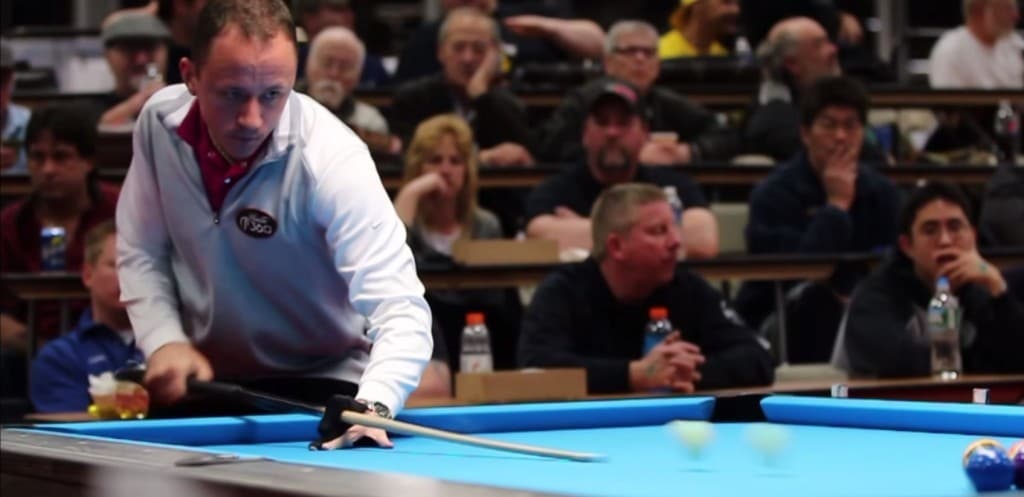Dieser Beitrag ist auch auf Deutsch verfügbar.
I am fundamentally not happy with the power of my pool break. For sure, I emphasize again and again that precision comes before speed. But in games like 8 or 10 Ball, on a certain level you just don’t get past the power in your break. For this reason, a few months ago I decided to start an experiment: do 500 break shots and see what I could learn from it.
Pool break 500 times
About 2-3 times a week I made 30 pool break shots – just racking the balls, breaking, racking the balls again. Half 10 Ball, half 8 Ball. This takes just under half an hour and has brought much knowledge.
1. Loose Wrist
The looser my wrist was during the break, the more power I could build up for the break. A loose wrist produces a small, final speed at the end of the shot, a little snap that again creates a little more speed. Or the other way around: a firm wrist decelerates the break at the end and doesn’t provide it with the length and power it needs. By the way, this applies to each shot, and especially to each break.
2. Come up earlier
When you observe professionals or good amateurs with good breaks (if you’re unsure who to watch, take Shane van Boening), you can see, that the player comes up during the pool break and stands virtually upright at the end.
And then, what I notice in many advanced players with a rather weaker break: the upwards movement looks nearly like that of a professional, the back leg may even come up, but at the front, at the rack? Not much happens there.
That often happens to me too: I have a lot of movement in the body (what we don’t really want for a normal shot) but at the front not much happens. Regarding this I always had the feeling that it had to do with the timing of my movement, but I could never identify it clearly.
During my experiments and the analysis of SVB´s break it became clear to me: the professionals come up before they make the shot. When you look at Shane, he is nearly totally upright when the cue hits the cue ball.
The backswing of the cue and the movement of straightening up the body happen quite simultaneously. And when the body is already upright, the shot comes forwards. Reason: The arm has more lever and can accelerate easier. This, of course, happens at the expense of precision, which is why the cue ball is more difficult to control.
Upwards, not forwards
Another difference: In my badly coordinated attempts I often moved forwards, instead of upwards. But by doing this I take speed away from the shot, instead of speeding it up more. So, be aware, that the movement of your body goes upwards, not forwards.
What I then did during my practices, for fun and to test myself a little, was to break in a completely upright position, without having bent down for a start.
And surprise: my break was already considerably more powerful. The insight is in any case: the sooner I come up before I shoot, the stronger my break is.
Here’s the video I used for analysis:
3. Going through further
A further improvement that I also observed by professionals: moving the cue forwards as much as possible. By doing this, the cue is speeded up for longer, and the cue ball has a shorter way to go before the impact, time in which it could slow down. [Edit: Some readers explained that this is physically not possible. I agree and I’m open for new explanations why following through works. Because it does, and that’s the actual point I’d like to make here.] Effect: a bigger bump. Likewise, in a video from Shane van Boening I saw how he broke an 8 ball rack on a 7 ft table: he followed through so far, he nearly touched the coloured balls in the rack.
4. Slowing down the back swing
One of the most important pool rules in general also applies to the break: “Slow down your backswing”. What is meant by it, is to pull the cue back slowly. Even if I want to break incredibly fast, especially when I want to break incredibly fast, I don’t need any backwards speed, but rather forwards. A slow backswing leads to more momentum and more control.
If I am not satisfied with my pool break and want more power, then I always watch these four aspects, and my break improves. Also, note that none of the four points says: use more strength. It´s not that. All the points aim at more swing, more speed and a better use of our levers. That´s why SVB´s break looks so soft but makes so much noise at the rack.
